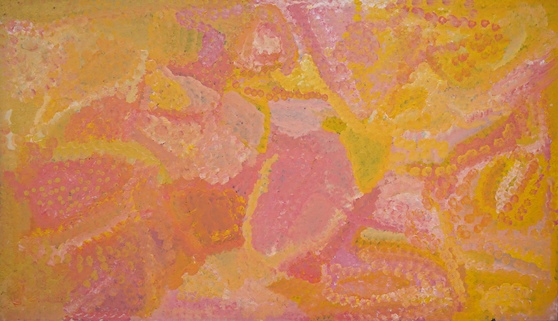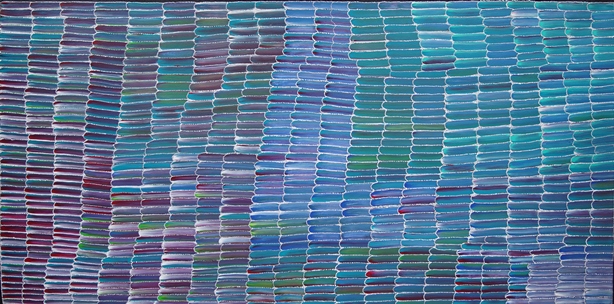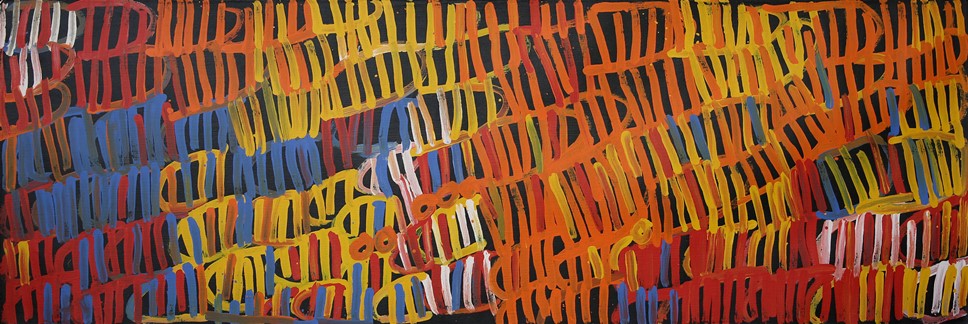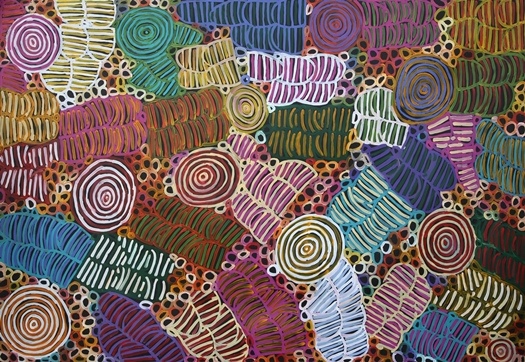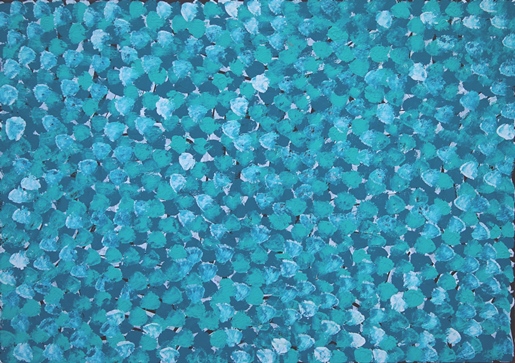The Vibrant Colours of Womens’ Yam Dreaming
Our new exhibition is Yam Dreaming and has ten major artists exhibiting. The theme of the exhibition is based on the Bush Yam, which is a staple of the traditional Aboriginal diet in Central Australia.
Because of its importance it has become a dominant theme, a central idea, for a significant group of artists to explore. There is a huge range of paintings on show, all on the theme of the yam. There are several different types of yams and the connection between the yam and the ceremonies and songs is explored in the paintings in different ways by different artists.
Emily Kngwarreye is the great example of an artist using the yam as part of a complete identity of herself and her role in an important traditional ceremony. Emily Kame Kngwarreye even had the word for yam seed built into her name. Two elements come together as a total identity – the person and a yam. She was the custodian for the ceremonies, and she would paint the many different aspects of the seasons and the growth of the yam plant.
Emily Kngwarreye is Australia’s highest selling female artist of all time. When one of her works sold for over one million Australian dollars, she became the first Aboriginal artist and the first Australian woman to have a work break through that one million dollar mark.
We have a work in this exhibition that is about 90 cm across. It is a classic Emily Kngwarreye painting where she selects colours that represent the plant at a particular stage of its growth. She paints the flowers and the seeds. Often she has the structures of roots and the vine plant, all embedded underneath the surface of the painting.
In this work we can see the warm colour palette, oranges and reds, with the white flowers and seeds spread out across the surface of the painting.
The other larger painting by Emily Kngwarreye is a composition totally in pinks and warm yellows. Again it uses the idea of either the yam and the flowers or the seasonal colours of the plant.
In many ways, it’s a very abstract idea. Emily was famous for pulling apart or deconstructing the yam story in her paintings and then drawing on particular elements of it that interested her for compositional reasons.
It could be elements of the flower or the seeds or the root patterns, because the women had to follow the roots down to find the big yam tubers at the end. They would use their digging sticks to get down to the yam tubers. All of these aspects were interesting to Emily the artist. She was a very senior woman in her late 70’s when she started painting. She only painted for seven or eight years of her life, right at the end. Emily was recognised as the most important spokesperson for the whole culture of Yam Dreaming in Central Australia.
Next to Emily’s paintings is a large painting by Jeannie Mills Pwerle, and this represents a different kind of yam. This is what they call the small yam or pencil yam, and Jeannie represents it through repeated images in a wide range colour tones. There’s everything from deep burgundies to aquas and blues, whites and purples and greens. This is her style. She paints these images of multiple pencil yams surrounded by tiny white seeds, little dots that separate each of the forms of the pencil yam. Her compositions are based on colour and the movement of colour across a painting that represents often hundreds of little yam images.
Another artist contributing to this exhibition is Minnie Pwerle who was famous for painting the decorative body designs that women painted on their bodies for ceremonies about the yam. There are also paintings by Betty Mbitjana which show the designs that women painted on their bodies in white ochre when they’re performing the yam ceremony.
The ceremonies contributed to ideas around respect for Ancestors and Country as being an important part of inherited culture. The participants were entreating a good harvest on their Country. By performing the ceremony of the yam, they were also by implication focusing on the well-being of their Country and the well-being of their people.
All these artists come from Utopia which comprises many small communities that are home to two language groups, the Alyawarre and Anmatyerre people.
Across from Betty’s painting is a painting by Galya Pwerle. This is a variation on the idea of body painting with yam flowers on top. In this painting, we can just see the remnants of the same body painting that we see in Betty’s painting and in Minnie Pwerle’s work. There are only small elements of the body painting to be seen in the white marks. They’re represented under layers of blues and greens and whites. These dots are a combination of the ceremony and the women’s roles in the body painting, and the ultimate reality of the yam.
Also included are two paintings by Rosemary Petyarre, and again the little yam leaves are finely decorated with the seeds all around them, this representing the natural aspects of the yam plant.
You will also see a work by Emily Pwerle, who is the third sister of Minnie Pwerle and Galya Pwerle. In this painting, we can see much more clearly the underpainting, the white decoration which is the body painting of the women. Over the top of it again she has placed all the flowers and seeds of the yam plant.
In this, we can still see the underlying layer of the body paint designs, very much as they appear in her sister Minnie Pwerle’s painting. These are the elements that ultimately Emily Kngwarreye pulled apart to expand the number of subjects or number of aspects of the whole Yam Dreaming story that she could bring out in her paintings.
This winter exhibition is full of vibrant colours and the life of the Central Desert. I think it is well worth a visit.
Read more:



